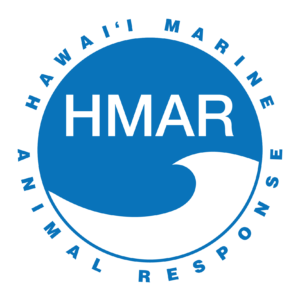MONTHLY HMAR UPDATE: April 2023
HMAR UPDATE: APRIL 2023
April was Earth Month and we had a pup born on Kaimana Beach so it has been busy busy busy! Read on for more information!
Number of Contacts Made to HMAR Hotlines in April 2023 – 971 (about 33 a day)
This was broken down as 738 contacts for Hawaiian monk seals, 156 for sea turtles, 17 for seabirds, and about 60 other contacts unrelated to the protected species we work with.
Number of Field Support Actions Conducted in April 2023 – 290 (about 10 a day)
This was broken down as 83 actions on the east side of the island, 65 on the west side, 5 on the north side, and 137 in the southeast area of the island.
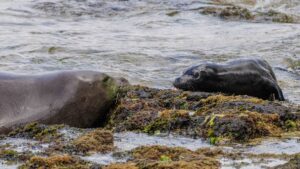 We had two Hawaiian monk seal pups born in April! On the 2nd of the month on an offshore island, PO4 was born. Our fourth pup being born in April was definitely earlier than we expected but we’re so excited to be adding new pups to our Oʻahu family! On April 14th, PO5 was born! If you haven’t seen us on our social media yet – RK96 “Kaʻiwi” gave birth to her fifth pup (and the 5th pup on Oʻahu of 2023) on Kaimana Beach in Waikīkī. Since then, we and our partners (NOAA, Ocean Safety, DLNR Division of Conservation and Resources Enforcement (DOCARE), DLNR Division of Aquatic Resources (DAR), DLNR Division of Boating and Ocean Recreation (DOBOR), and Honolulu Police Department have been working together to manage a larger perimeter than usual to ensure human and seal safety. We have been on the beach 14 hours each day since birth and will continue to be for the foreseeable future! PO5 will also be gifted a name by Waikīkī Elementary School in the coming weeks and we’ll announce that on our social media.
We had two Hawaiian monk seal pups born in April! On the 2nd of the month on an offshore island, PO4 was born. Our fourth pup being born in April was definitely earlier than we expected but we’re so excited to be adding new pups to our Oʻahu family! On April 14th, PO5 was born! If you haven’t seen us on our social media yet – RK96 “Kaʻiwi” gave birth to her fifth pup (and the 5th pup on Oʻahu of 2023) on Kaimana Beach in Waikīkī. Since then, we and our partners (NOAA, Ocean Safety, DLNR Division of Conservation and Resources Enforcement (DOCARE), DLNR Division of Aquatic Resources (DAR), DLNR Division of Boating and Ocean Recreation (DOBOR), and Honolulu Police Department have been working together to manage a larger perimeter than usual to ensure human and seal safety. We have been on the beach 14 hours each day since birth and will continue to be for the foreseeable future! PO5 will also be gifted a name by Waikīkī Elementary School in the coming weeks and we’ll announce that on our social media.
Number of Rescues, Interventions, Stranding Responses and Escalated Field Actions in April 2023 – 19
This was broken down as 7 operations on the east side, 6 on the west side, 2 on the north side, and 4 in the southeast side of the island. These escalated activities included 10 operations for sea turtles, 7 operations for seabirds, and 2 operations for Hawaiian monk seals.
Here are a couple of highlights from these operations.
At the end of April we received a call while some of our team was on the North Shore. An adult turtle was on the beach at Laniakea Beach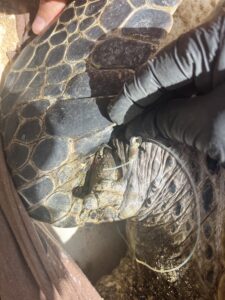
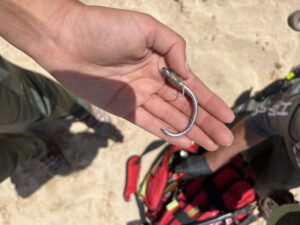 with a large hook in its right fore flipper. Our team was able to be there in a matter of minutes due to their close proximity. The turtle was basking on the beach and our team was able to capture the animal, assess its condition, and examine the hook. The ulua hook had about 12 inches of line which was thankfully not entangled around the animal. The hook had gone completely through the flipper and the barb was on the other side. The sea turtle was otherwise in good body condition and appeared healthy. This meant that by using a pair of bolt cutters we were able to cut the hook point and barb end and remove the rest of the hook with the line attached. The turtle was very strong and active (it actually broke our bin that it was contained in) and was released immediately after!
with a large hook in its right fore flipper. Our team was able to be there in a matter of minutes due to their close proximity. The turtle was basking on the beach and our team was able to capture the animal, assess its condition, and examine the hook. The ulua hook had about 12 inches of line which was thankfully not entangled around the animal. The hook had gone completely through the flipper and the barb was on the other side. The sea turtle was otherwise in good body condition and appeared healthy. This meant that by using a pair of bolt cutters we were able to cut the hook point and barb end and remove the rest of the hook with the line attached. The turtle was very strong and active (it actually broke our bin that it was contained in) and was released immediately after!
We also had an injured brown booby rescue at Baby Makapuʻu Beach. The bird was sitting on the rocks creating a tide pool with a drooping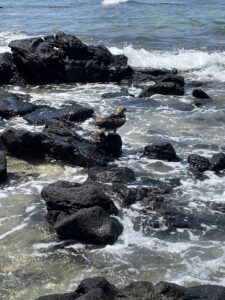 wing. The tide was quickly coming in and the bird was continuing to lose its balance and almost fall into the water. Our team was able to respond and carefully retrieve the bird and assess its condition. It had very high energy levels and tried to escape capture, but without working wings it didn’t have much success. We were able to gently capture this beautiful seabird and transport it to our partners at Feather and Fur Animal Hospital in Kailua for veterinary support.
wing. The tide was quickly coming in and the bird was continuing to lose its balance and almost fall into the water. Our team was able to respond and carefully retrieve the bird and assess its condition. It had very high energy levels and tried to escape capture, but without working wings it didn’t have much success. We were able to gently capture this beautiful seabird and transport it to our partners at Feather and Fur Animal Hospital in Kailua for veterinary support.
Remember, if you see a marine protected animal of concern, please do not attempt to intervene. This can be dangerous for you, can result in further problems for the animal, does not allow us to conduct a proper assessment and examination of the animal, and likely constitutes a violation of federal and state laws. What is most important is that you call the statewide marine animal hotline at (888) 256-9840 as quickly as possible, provide photos, and detailed GPS or location information. Your quick and detailed contact will allow us to determine the best action to take and allows us to dispatch trained and permitted responders as needed.
Marine Debris – New Programs and Projects!
Last month we dove 4 times and collected 2,275 feet of monofilament and 110 animal hazards that pose an injury or death threat to Hawaiian monk seals, sea turtles, and seabirds. During these dives we cleared about 6.5 acres of underwater habitat!
Last month we were thrilled that we received a contract from the State of Hawaiʻi DLNR Division of Aquatic Resources (DAR) to be their

designated partner for their Marine Debris Rapid Response program on Oʻahu. Every month we dive all around Oʻahu’s nearshore waters to collect underwater entanglement hazards. This contract will expand our Marine Debris Program to also include debris on land including large derelict nets on shore and at sea! We’re happy we’re able to continue to grow our partnership with the State of Hawaiʻi and to have new opportunities to support the health of Oʻahu’s ocean ecosystem.
Number of People Reached Through Face to Face Outreach and Education in April 2023 – 2,801
 April was Earth Month! Our Education team was extremely busy with four events over the course of two weekends. During Earth week we talked with the public about the dangers of plastic pollution and derelict fishing gear for Hawaiʻi’s marine protected species. Over the course of those four events we talked to almost 1,000 people! We also reached an additional 1,800 people through outreach conducted during our ongoing field response, rescue, and other support activity.
April was Earth Month! Our Education team was extremely busy with four events over the course of two weekends. During Earth week we talked with the public about the dangers of plastic pollution and derelict fishing gear for Hawaiʻi’s marine protected species. Over the course of those four events we talked to almost 1,000 people! We also reached an additional 1,800 people through outreach conducted during our ongoing field response, rescue, and other support activity.
Additional News & Updates
This month we hired two new staff positions. Cameron Aroz is our new Operations Support Technician. Cam was an HMAR intern earlier this semester and in the middle of her internship we scooped her up and brought her onto our staff team. She is a graduate of University of Oregon with a degree in Multidisciplinary Science with a Marine Concentration. Jace Reinken was also hired as a Marine Support Technician. Jace was an HMAR intern in the summer of 2022 and graduated from UH Mānoa last fall. We are so excited to have both Jace and Cam joining the HMAR team, and if you see them in the field, be sure to say hello!
was an HMAR intern earlier this semester and in the middle of her internship we scooped her up and brought her onto our staff team. She is a graduate of University of Oregon with a degree in Multidisciplinary Science with a Marine Concentration. Jace Reinken was also hired as a Marine Support Technician. Jace was an HMAR intern in the summer of 2022 and graduated from UH Mānoa last fall. We are so excited to have both Jace and Cam joining the HMAR team, and if you see them in the field, be sure to say hello!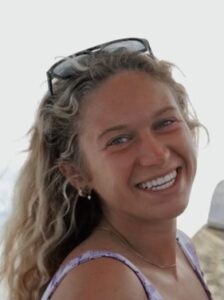
This month we also officially began our offshore islands sea turtle nest surveys for the 2023 season. Our team will be using our kayaks and our Rescue 1 vessel to access these islands to search for nesting indicators. We’ll be tracking these potential nesting sites for our partners at the U.S. Fish and Wildlife Service Pacific Islands Coastal Program..
As a reminder – if youʻre interested in volunteering with us please go to HERE. Our next new volunteer orientation is on Saturday May 20th so there is still time to apply and get a seat in upcoming training. If you can’t volunteer we still could use your help. Please go HERE to give your financial support so we can continue our important work.
Mahalo for your support!
______________________________________________________________________________
WHAT DO THESE NUMBERS MEAN?
Number of Calls – What does this mean? These are calls our hotline operators answer about any species in any situation. Whether it is a monk seal on the beach, a sea turtle of concern in the water, or a seabird that needs help. HMAR answers the calls that are made to the NOAA’s marine wildlife number for Oʻahu and Molokai and we take calls from the public, from the police, fire department, Ocean Safety as well as State of Hawaii agencies. Any call that comes into our hotline is reported here. Some calls result in a field response but many are valuable for animal sightings information or other data that can assist in research. Since our start in 2016, we’ve handled over 58,000 hotline contacts.
Number of Field Support Actions – What does this mean? This is when HMAR sends volunteer or staff resources into the field to perform a variety of actions in support of marine protected animals including Hawaiian monk seals, sea turtles, sea birds, dolphins, and whales. Since our start in 2016, we have had volunteers or staff in the field over 25,000 times.
Number of Rescues, Interventions, Stranding Responses and Escalated Field Actions – What does this mean? This number includes any field response that goes above and beyond a typical resting monk seal response. This includes responding to a seal of concern, an entangled, hooked, or injured sea turtle, a seabird in need of medical support, and other situations. Since 2016, we have performed over 2,145 of these operations.
Marine Debris Work – Each week our marine debris team removes underwater entanglement hazards (net, line, hooks) from high fishing pressure areas to reduce animal entanglements, hookings, injuries and death of protected marine animals. Since we started our underwater removal activities, our Marine Debris Program (MDP) has removed more than 4,300 animal hazards, cleaned over 270 acres of underwater habitat, and we have collected many MILES of monofilament fishing line. Taking all of this debris out of underwater habitat helps save Hawaiian monk seals, sea turtles, and seabirds.
Number of People Reached through Face to Face Outreach – What does this mean? HMAR’s different program activities put our volunteers and staff in direct contact with Hawaii’s residents and visitors. Educating people about Hawaii’s marine protected species and our ocean ecosystem is one of our highest priorities and has an important impact on reducing threats. This number includes outreach done on the beaches as well as the work our Education and Engagement team does going to classes and community outreach events. Since our start we’ve reached over 303,000 people.
